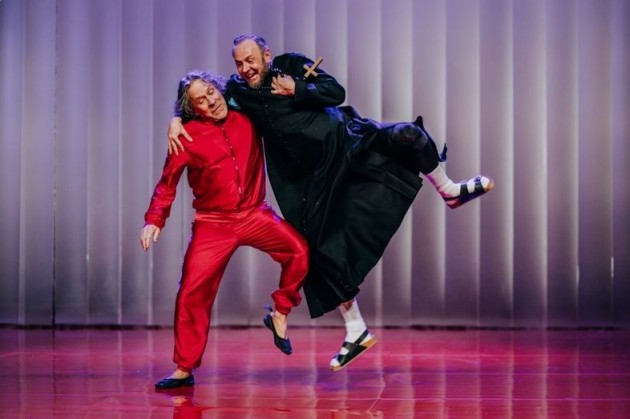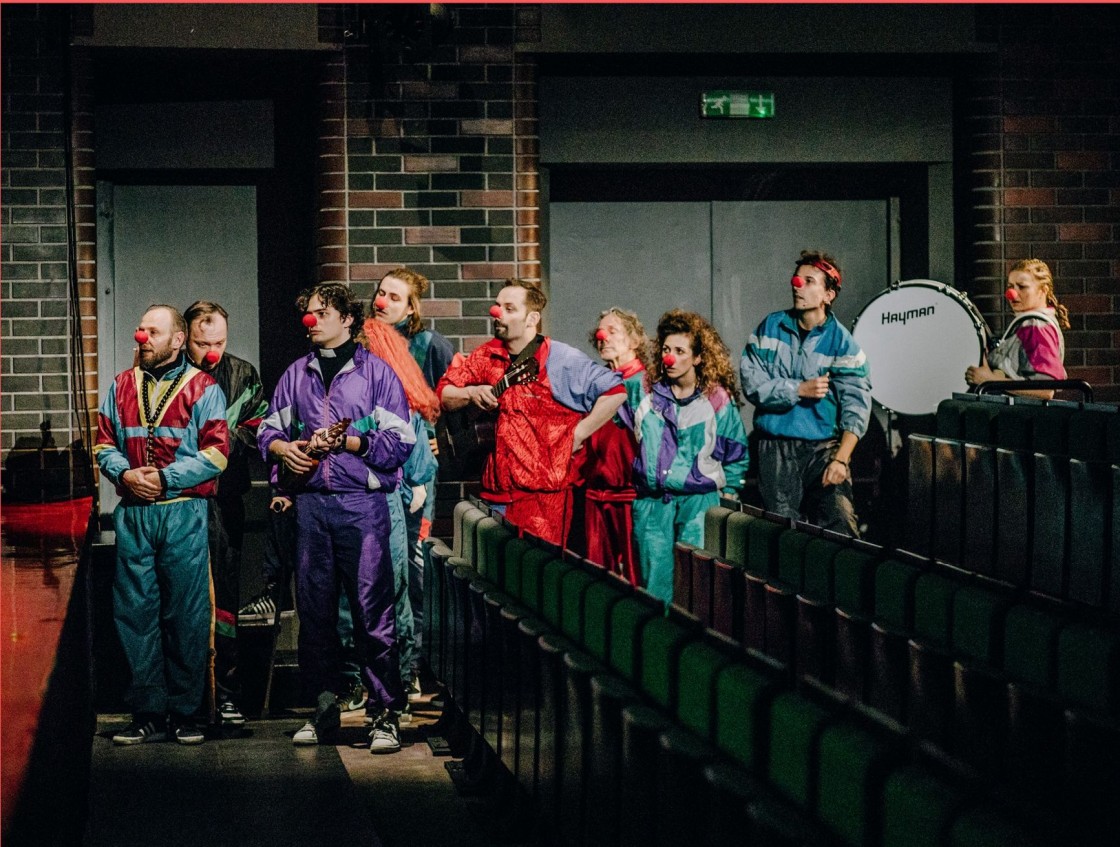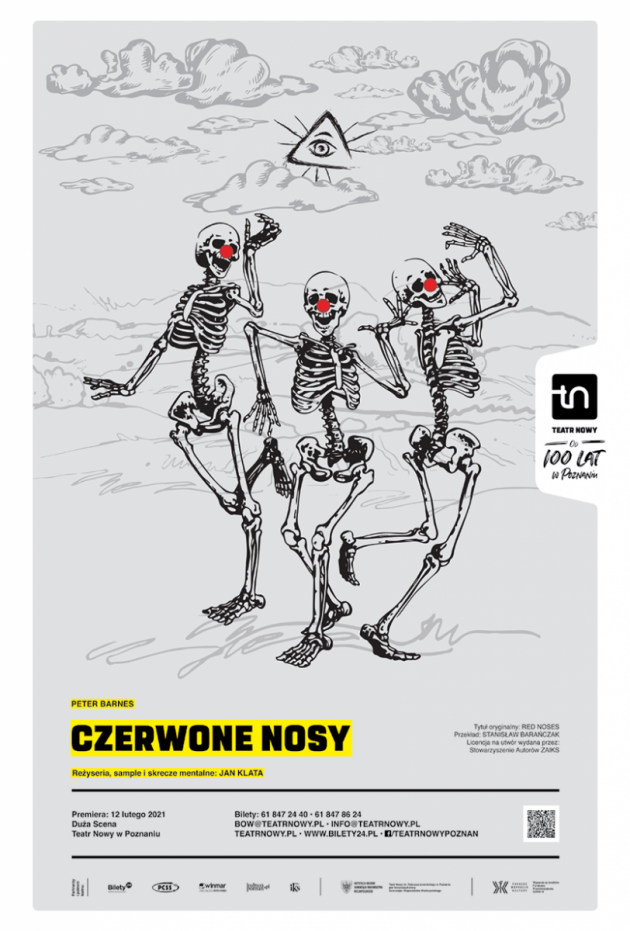Awooo…!

We often speak of a "voice crying in the wilderness", but the play I am reviewing leaves us with nothing more than "Emptiness. Desert. Void". In the final act of "Red Noses", directed by Jan Klata, we hear a voice that offers neither prayer nor a complaint; there's no verbal message nor a clear recipient. It’s howling into nothingness.
It's the howling of someone who has nothing left, an action more instinctive than intentional; and because it's a cry from the highest Church dignitary, it sounds pathetically grotesque. But this ending is more tragic than the excessively four-hour-long clowning, and the tone in which Klata plays out Peter Barnes' lengthy drama. The images of the carnivalesque subversion of order in 14th century France caused by the Black Death and the attempts to fight it written by the author, adapted by the director, are, of course, pretexts to discuss current times.

The foundation of the European world has always depended on the alliance between the Church and the Monarchy against Everyman. After a crisis, those in power unite and are ruthlessly quick to return to the old ways of governing, which may be no less damaging than the plague. There is no community, only common interests and their restoration; there is no hierarchy of values, only hierarchy of people. The order of Christ's Clowns, called to life during the plague, has to be terminated - the jokes cease to be funny or healing, they become socially threatening. Even more so because too few Jews have survived; thus, defusing the mood with a controlled pogrom becomes impossible.
Similarly to what he does in "Mother Joan of the Angels", Jan Klata leaves the audience of the Poznań Nowy Teatr (New Theatre) with no illusions about the present and little hope for the future. Once again, the result is that I care little about what I liked or what disappointed me in this play, that it was too long, or the first act spread boredom, that actors did this or that... What matters is the moment when I feel that the theatre is telling me something that's important now, when the artists share my anxiety.
Some spectators sitting near me did not return to their seats after the interval. Others - remembering the theatre's 1992 stage adaptation of the same play - did not hide their disappointment, if not disdain, at Klata's work, refusing to honour the creators and artists with so much as a round of applause. However, the play also deals with these kinds of public reactions, including bursting into applause; it talks about what theatre means to people, why they need artists, and several other "lofty" matters.
What we have here are the "Red Noses" of the era of the coronavirus pandemic, mass street protests for crucial social matters and the crisis of the Church.
Whoever so desires, can succumb to the charms of the theatre's allusions, which the director crudely, provocatively makes, as if to test us: whether we will burst into cackles of laughter or reflect. Christ's Army likes militaria: the Pope uses a cross-shaped rifle to shoot, rosaries serve as nunchakus and slingshots, Archbishop Monselet changes his draped gown-like cassock for a tiara and the cassock itself becomes a camouflage print uniform. The white surplices of the "altar boys" acquire the colour and attributes of police reflective jackets, while the candles in their hands resemble batons. The scene of the open confrontation with the street of vibrant young people is like a furnace capped by a cordon of surplices and balaclavas behind plexiglass shields. In "The Nativity", a play performed by the Red Noses in a public square, the Three Wise Men are presented respectively as a stereotypical Chinese man in a pointed hat, an actress wearing blackface and holding a banana in her hand, and the bison man from the Trumpist raid on the Capitol. In “Everyman”, Everman's family wear striped outfits that resemble concentration camp prisoner clothes rather than pyjamas, which becomes even more pronounced when characters in fascist uniforms appear next to them. Justyna Łagowska's costumes speaks loudly in a witty fashion about various plagues of our times (consider the flagellants’ phenomenal "armour”).
As usual, the director relies on popular music, here mixed with religious songs, to make his narrative appealing. The hymn of the Red Noses that brings cheer to a pestilent world is America’s road ballad "A Horse with no name" which sounds like a fervent song of the oasis in the Polish translation. The Wild West is "Poland - the wild country", but also the stage, the audience, the foyer, the backstage of Teatr Nowy which is the road traversed by the ragtag group in familiar baggy polyester tracksuits. The man with the mission, Father Flote leads, followed by various cast-offs and a church spy. They sing Nirvana's "Smells like Teen Spirit" in Latin, while the "Song of Farewell" is performed in the style of popular dance music, disco polo. The playlist also includes The Cranberries' "Zombie" or songs by Metallica. In "The Nativity" scene, the Holy Mother hums Deep Purple's "Child in Time" to the crucifix wrapped in the hem of the dress. The corpse-robbing Black Ravens are depicted as female death metal bass players.
Klata celebrates this kind of theatre (and metatheatre) with a truly epic and farcical flair, but at the same time, keeps the Pope's theme subtle. Clement VI is disgraced on par with other Church figures, even literally bared in a massage scene. However, from the first appearance of the actor who plays him - Ildefons Stachowiak, we also hear him speak in a tone that is not caricaturish. Perhaps he is a rationalist with eschatological awareness, albeit a cynic? The actor plays his role brilliantly, reflecting the majesty of his character mainly with his voice and costume; his portrayal is very natural and real. Posing on the papal throne enclosed in an isolation room, he seems to take on the features of Pope Innocent X from Francis Bacon's canvases. Except here, unlike in Bacon's painting, we don't hear the Pope scream until the final act, when he howls out his pathetic "Awooo…!" Neither do we see his face, a topic of major interest for the British painter, because Stachowiak stands with his back to the audience, at an angle, raises his head slightly and howls like a lone wolf or dog at the moon. Except the firmament is empty. That's the image of the contemporary Church.
Faith is one of Jan Klata’s favourite themes, and perhaps especially the figure of the Pope and the relation of this allegedly holy person to reality and the transcendent. Starting with the debut “Uśmiech grejpfruta” / "The Smiling Grapefruit" through such plays as “Lochy Watykanu” / "The Dungeons of Vatican", "Mother Joan of the Angels", and now "Red Noses", Klata contrasts hierarchy, media technology, and popular culture with the relics of faith of the folk church and the lowest-ranking servants of God. He pits the glitter of institutions against the spiritual emptiness of the material world.
How does one depict this emptiness on the stage without descending into the banality of open curtains or a box filled with black? Justyna Łagowska offers a simple solution, yet one that speaks louder than words, of which there is definite excess in Poznań's Teatr Nowy.
She leaves the box scene literally in the form of a box, with four walls erected from transparent vertical screens that are not blinds but, rather, resemble enclosures found in facilities where checking and maintaining cleanliness is essential. The chief visual devices are a red floor and white walls enhanced by light, nothing more. Eventually, an ordinary stage platform rolls in and serves as a theatre in the public space. Other elements of stage set appear for a while, like props needed for particular scenes: the table for the Noses' last supper or the papal kneeler-massage table.
The play begins with a closed quadrangle consisting of vertical screens. Inside, we see bodies clad in black and white. What plague is this? Klata does not keep us guessing for long, as a medic in a Covid protection suit tends to the dead. The administered remedies work, the cured brush down their robes - they are servants of God in black cassocks and white surplices. The fourth wall is raised, the pestilence spills into the world along with those who seek to profit from it and those who seek to remedy it. We already know what the final image is. However, what happens in between is no longer the vague church with an absurd ceiling that we know from Gombrowicz’s work. While the vertical screens might bring to mind the cornices and columns of Gothic temples, this space has no deformed altars, impossible gates, no psalters or chalices; the seal has sunk and the only thing that remains is the frozen abyss. An isolation cell enclosed with a buckle of falsehood.
I understand that Teatr Nowy is returning to art that builds the company's identity; Eugeniusz Korin's stage adaptation of “Red Noses” ran for a decade. The erstwhile artist-idealist Flote, Janusz Andrzejewski, now plays the mute Sonnerie who uses bells to communicate. He's the only member of Noses who doesn't wear a tacky tracksuit. Justyna Łagowska has dressed him in a red satin outfit and black ballet shoes. Is he the Stańczyk figure, the fool whose bells are meant to arouse fear? The well-crafted British play from 1985 fits into the "here and now" but I prefer Jan Klata's theatre when the director takes on such works as Małgorzata Sikorska-Miszczuk's "Szajba" / "Loose Screws" or Bożena Keff's "Utwór o Matce i Ojczyźnie" / "On Mother and Fatherland".

Teatr Nowy in Poznań
Peter Barnes “Red Noses”
Polish translation by Stanisław Barańczak
Direction, literary samples and mental scratches: Jan Klata
Stage design and costumes: Justyna Łagowska
Music: Jakub Lemiszewski
Choreography: Maćko Prusak
Premiered on 12 February 2021